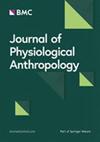1.5年和3年健康检查时的体重和14岁时的体脂:一项基于人群的回顾性队列研究,使用双能x线吸收仪
IF 3.1
4区 医学
Q1 Social Sciences
引用次数: 0
摘要
在日本,根据法律要求,所有儿童出生时的身高和体重测量以及1.5岁和3岁的健康检查都记录在《母婴健康手册》中。本以人群为基础的回顾性队列研究旨在评估手册中身高和体重记录在预测青少年过度肥胖方面的诊断性能。源人群包括在两所公立初中注册的8年级学生(800名14岁学生)。其中,我们排除了胎龄< 37周或> 42周出生的学生。目前的分析包括435名提供完整信息的参与者。使用身高和体重记录计算身体质量指数(BMI)。采用双能x线吸收仪(DXA)测量14岁时的体脂量。使用受试者工作特征(ROC)曲线分析评估从MCH手册记录计算的BMI诊断性能,以区分14岁时是否存在过度肥胖。ROC曲线下面积(AUC)用于量化BMI的诊断准确性。对于14岁时过度脂肪的预测,1.5岁和3岁时BMI的auc和95%置信区间均大于0.5。同时,出生时BMI的AUC不显著大于0.5。目前的研究结果表明,使用MCH手册数据计算的BMI值具有区分14岁时是否存在过度脂肪的潜在能力。本文章由计算机程序翻译,如有差异,请以英文原文为准。
Body weight at 1.5- and 3-year health checks and body fat at 14 years of age: a population-based retrospective cohort study using dual-energy X-ray absorptiometry
In Japan, height and weight measurements, taken for all children at birth and 1.5- and 3-year health checks, are recorded in the Mother and Child Health (MCH) Handbook, as required by the law. The present population-based retrospective cohort study aimed to evaluate the diagnostic performance of height and weight records in the Handbook for predicting excessive adiposity in adolescents. The source population consisted of 8th grade students (800 students aged 14 years) registered at two public junior high schools. Of these, we excluded students who were born at a gestational age < 37 weeks or > 42 weeks. The present analyses included 435 participants who provided complete information. Body mass index (BMI) was calculated using height and weight records. Body fat mass at 14 years of age was measured by dual-energy X-ray absorptiometry (DXA). Diagnostic performance of BMI calculated from the MCH Handbook records to discriminate between the presence and absence of excessive adiposity at 14 years of age was evaluated using receiver operating characteristic (ROC) curve analysis. The area under the ROC curve (AUC) was used to quantify the diagnostic accuracy of BMI. With regard to the prediction of excessive fat at 14 years of age, AUCs and 95% confidence intervals for BMI at 1.5 and 3 years of age were greater than 0.5. Meanwhile, the AUC of BMI at birth was not significantly greater than 0.5. The present study findings indicate that BMI values calculated using MCH Handbook data have potential ability to distinguish between the presence and absence of excessive fat at 14 years of age.
求助全文
通过发布文献求助,成功后即可免费获取论文全文。
去求助
来源期刊

Journal of Physiological Anthropology
Social Sciences-Human Factors and Ergonomics
CiteScore
4.80
自引率
6.50%
发文量
39
审稿时长
>12 weeks
期刊介绍:
Journal of Physiological Anthropology (JPA) is an open access, peer-reviewed journal that publishes research on the physiological functions of modern mankind, with an emphasis on the physical and bio-cultural effects on human adaptability to the current environment.
The objective of JPA is to evaluate physiological adaptations to modern living environments, and to publish research from different scientific fields concerned with environmental impact on human life.
Topic areas include, but are not limited to:
environmental physiology
bio-cultural environment
living environment
epigenetic adaptation
development and growth
age and sex differences
nutrition and morphology
physical fitness and health
Journal of Physiological Anthropology is the official journal of the Japan Society of Physiological Anthropology.
 求助内容:
求助内容: 应助结果提醒方式:
应助结果提醒方式:


